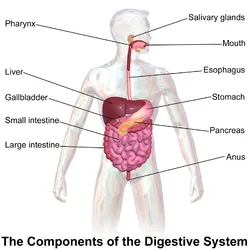The food we eat gives us energy to work and other activities that needs energy. Without food the other parts of the body like bones, muscles and the internal organs do not have energy to functions. However, before our body can make used of any food that is eaten, it must be broken down into liquid form or into smaller nutrients. The process by which food is broken down into nutrients is called Digestion.

Image Source
Digestion takes place as soon as we start to chew our food. The tounge, lips, and cheeks move the food between the teeth to break it down into small pieces. Saliva from the salivary glands mixes with the food to soften it. Saliva also kills bacteria and breaks down starches into sugars. Moist food from the mouth goes down to stomach.
The stomach is a large organ that is lined with layers of muscle. As the muscle contract and relax, food in the stomach is squeeze, twisted and churned. While the food is being physically changed in the stomach , digestive enzymes and juices are also combined to change it into nutrients. The process of digestion is both chemical and mechanical. The chemical parts of digestion is the mixing of food particles with chemicals in the saliva and stomach which changes it into nutrients that can be absorbed by the body. While the mechanical parts break down into small bits by the chewing of food in the mouth and squeezing of food particles in to the stomach. Further action of enzymes in the small intestines complete the process of chemical digestion. Food stay in the stomach for four hours until the food turns into a thick liquid. The food that has been moistened, chewed and mix with chemicals or enzymes in the stomach goes down into our small intestine. The walls of the small intestines are made of muscles that squeeze food and continuously move it. It contains digestive juices and other enzymes that help break the food into nutrients. The nutrients are then absorbed by the small intestines then go into our blood stream. The blood carries these nutrients to the different parts of the body.
